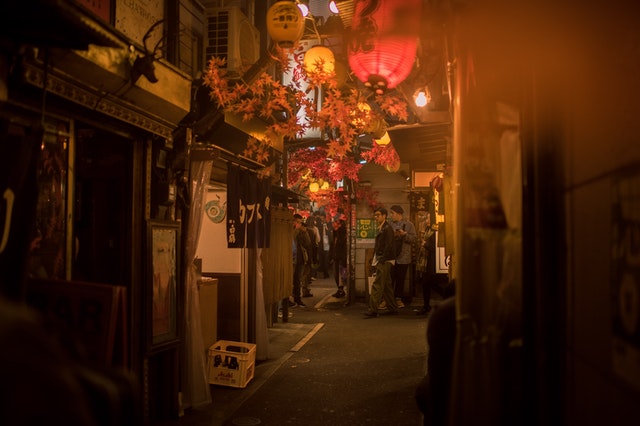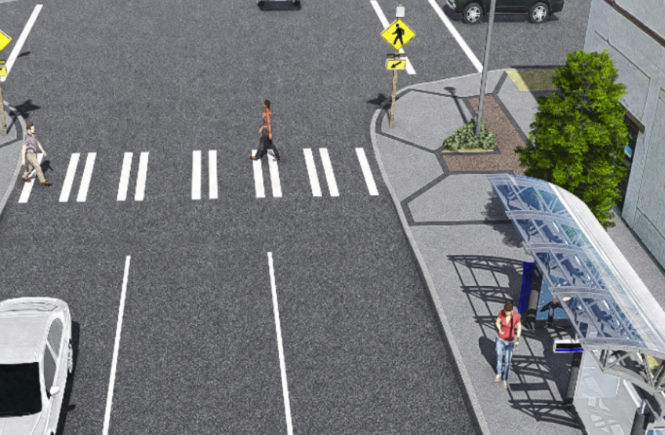
The difference between roads and streets is often overlooked but important in creating livable cities. Listen to any Bruce Springsteen song and you’ll probably hear a reference to “the street”. This is often accompanied by stanzas about how he spent a summer building a ’72 Challenger from scratch or found spiritual salvation in the hum of an inline V6. While Springsteen uses “streets” and “roads” interchangeably, the terms are often confused by planners and engineers as well. Here’s the difference:
Roads
- Exists separately from neighborhoods, civic engagement, and anything else that doesn’t fit into a traffic model. A line on a map without context to its surroundings.
- Efficient, but fragile. Its primary purpose is to move traffic like a pipe moves water. A small disruption can lead to complete failure.
- Very serious business. Measured by delay, congestion, level of service.
- Very “Platonic” as defined in Taleb’s critique of predictability in The Black Swan
” (top-down, formulaic, inside-the-box, skeptical).
Streets
- A civic stage. A platform for creative, social, and economic life.
- Robust and complimentary. Multiple activities on the street encourages a healthy public space.
- Democratic and “bottom up”. While infrastructure is built by the city, adaptable and community driven uses gives a neighborhood ownership of the street.
- Playful, intuitive, exists with neighborhoods, not despite them.
Charles Marohn at Strong Towns explains the difference between roads and streets using the concept of capturable value. Roads designed to be “safe to a fault” have been the status quo for a long time:
Roads move people between places while streets provide a framework for capturing value within a place.
The value of a road is in the speed and efficiency that it provides for movement between places. Anything that is done that reduces the speed and efficiency of a road devalues that road. If we want to maximize the value of a road, we eliminate anything that reduces the speed and efficiency of travel.
The value of a street comes from its ability to support land use patterns that create capturable value. The street with the highest value is the one that creates the greatest amount of tax revenue with the least amount of public expense over multiple life cycles. If we want to maximize the value of a street, we design it in such a way that it supports an adjacent development pattern that is financially resilient, architecturally timeless and socially enduring.
Well said. Pick the average state highway, neighborhood street with average speeds of 35+ mph, or 6 lane urban arterial which prioritizes auto traffic, and you’ll see an example of a road. These roads often try to be both a street and road, but fail at both. For instance, a state highway designed to funnel traffic as quickly as possible with numerous curb cuts serving auto-centric big box stores is neither an efficient road nor a neighborhood enhancing street. By trying to serve both through trips and local trips in such a mono-modal fashion, and by encouraging inefficient and economically draining development patterns, these types of roads erode both a sense of place and revenue generating opportunities for communities.
Finding examples of streets is less clear cut, but far more interesting. Luckily, Daniel Toole has done a great job of documenting the best examples of streets, which are alleys. His blog (and his book, “Tight Urbanism“), is a photographic journey into alleys all over the world. When streets are tightly framed by buildings and surrounded by a mix of uses, something magical happens. It’s the sense of serendipity- turn a corner and you may find an exotic fruit vendor, a busker playing your new favorite song, or a Thai restaurant tucked into a small corner.
Alleys work great as streets because they create an intimate streetscape which serves as a stage for outdoor cafes, performers, and other activities. Consider Donald Appleyard’s research showing that residents of streets with light traffic had three times more friends and twice as many acquaintances as the people who lived on streets with high volumes of traffic. It stands to reason that alleys take this concept to the next level, with the social capital of alleys surpassing even low volume streets and providing more opportunities for social interaction and street life. It can also be argued that alleys are streets in their purest form – primarily a civic stage, robust, “bottom up”, and contributing to civic life.
Jackson Heights Plaza in NYC is a great example of a road turned into a street. Continuing the precedent of public plaza installations throughout the city, travel lanes converted into new outdoor cafes and other people-oriented uses have energized neighborhoods, increased foot traffic and given a boost to local businesses.
Streets converted into pedestrian plazas were a city planning fad in the 1970s and 1980s and were expected to revitalize downtowns, but instead, the conversions often created dead zones due to poor management and lack of foot traffic. NYC’s program strategically locates plazas by selecting sites with active retail, tourism magnets, and abundant foot traffic. The plazas have also been a boon to nearby businesses. Would you rather shop next to loud 45 mph traffic, or on a street where people are encouraged to stroll into your shop through a peaceful pedestrian space?
The Tactical Urbanism Guide from The Street Plans Collaborative is a excellent guide to creative, community focused public space projects. A lot of examples focus on low cost, short turn-around projects non profits and community groups could initiate. Small things like adding chairs to a street corner, creating a garden out of a vacant lot, or building a mini-park out of sod, benches and portable planters in a parking space can change how neighborhoods think about streets and public spaces. The very process of planning and building these projects can also strengthen communities.
With streets and roads often making up more than 15% of the total land area of cities, dedicating so much space to automobiles is becoming an increasingly inefficient use of right of way. Self-driving cars may also reduce car ownership rates and parking demand, leaving many over-built roads under utilized. While states and cities are spending enormous amounts of money to build new highways and widen roads, there should be a better return on investment than simply shaving 2 minutes off of an automobile trip.
Finally, I can’t mention livable streets without mentioning the Open Streets Initiative, an effort to bring Bogata style Cyclovias to cities across the U.S. Open Streets events close off a series of streets to traffic (usually on Sunday) to encourage physical activity, community events, and local business patronage. These events also bring people from diverse walks of life together by converting roads to streets, if only for a few days a year.
The true value of a street isn’t only the efficient movement of vehicles, but the social, economic and urban design benefits it brings to the neighborhoods it runs through.




